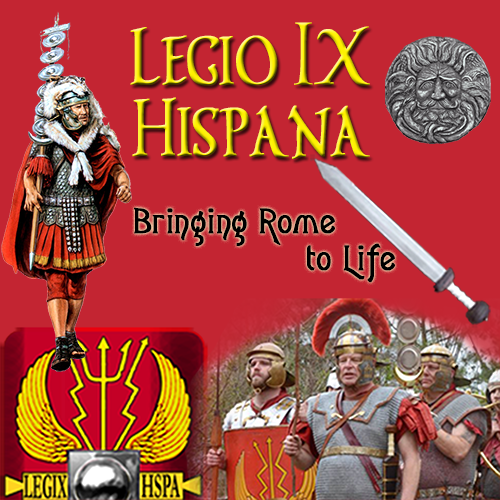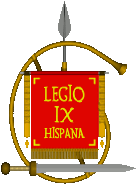Tunica (tunic)
The basic item of Roman military clothing was the tunica. In the 1st Century AD, tunics appear to have been made from two rectangular pieces of cloth woven to the desired dimensions (i.e. with selvedges on all four edges) and sewn together at the sides and shoulders (Graham Sumner, Roman Military Clothing, 20). Openings were left for the arms and head. The cloth extended beyond the shoulders and covered the upper arms. The military tunica was shorter than the civilian style in that it ended above the knees when it was pulled up under the belt; tunics for male civilians usually covered the knees.
Although tunics were made in different sizes to fit different individuals, they were usually very wide and wider than they were long. leaving a lot of excess material at the sides which gave tunics the baggy appearance depicted on period sculpture (Sumner, 27-28, 30-33).
Color
There is disagreement among scholars and reenactors as to the color of Roman military tunics, or whether different colors were worn by differing units or military ranks, or for different occasions. Sumner lists all of the known evidence for the colors of military clothing arranged in chronological order (pages 121-32). What evidence exists for our period suggests that Roman legions wore red dyed tunics for war, white tunics for formal occasions such as parades, and undyed tunics for other uses.
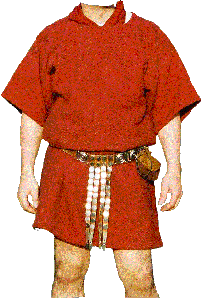
Legio IX Hispana, following this evidence, wears tunics either dyed with madder or a modern deep red dye that approximates what could be achieved with madder for all military activities — which comprise the bulk of our activities. White tunics with clavi could be worn for parties or special scenarios, while undyed tunics are acceptable for fatigues or off-duty wear at immersion events.
The Legio IX Tunica
The preferred tunica for Legio IX Hispana is the sleeveless pattern comprised of two rectangles sewn together with openings for the arms and head. It should be wider than it is long.
Fabric:
100% wool. NO cotton, silk, or any man-made fibers! Linen may be used for white or undyed tunics and undertunics.
Color:
Deep red. Madder dyed fabric is preferred.
Dimensions:
- Length: Measure from from the top of the shoulder to just below the knee (be sure to add an extra 1/2 inch for the shoulder seam and 1 inch for the bottom hem, if needed, when cutting the cloth)
- Width: 110% to 130% of the length measurement (wider than the distance between both elbows with arms outstretched)
- N: Neck opening, about 16" for average necks (or wider, see note below).
- A: Shoulder seams. To determine "A" subtract the neck opening from the width and divide by 2.
- Arm Holes: 10" - 11", slightly larger for larger arms.
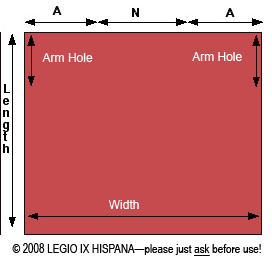
Construction:
- Hand sew the shoulder seams with a simple running stitch, using linen thread. All seams should be ½" wide. Hand-stitching should be 5 or more stitches per inch. Match the outside edges and sew towards the neck.
- The hem (bottom edge) should be a selvedge or factory edge (if that is not practical, a 1-inch hem should be used).
- Clean finish the seam edges by trimming any fabric threads that stick out.
Notes:
- The length of the finished tunica should be above the knee when belted. It is recommended that the pieces of cloth be pinned together and tried on, and then belted, before the final cutting of the cloth and sewing commences to make sure the look and wear of the tunic is right. The tunica is designed to be worn with or without bracae or feminalia (calf-length breeches).
- Depictions on Trajan's columns of soldiers doing work fatigues indicate that the tunic could be worn with the right arm protruding from the neck slit to bare the shoulder. This means the neck slit was larger than what is suggested. The method to narrow the neck slit when not doing fatigues is also indicated on Trajan's column: fabric behind the neck was bunched up and tied off with a cord. Experiments with tunics designed and worn this way show that this not only narrows the neck slit but also makes the front of the slit hang down lower, as well as produce the draping effect portrayed in sculpture (Sumner, 36-36, 40).
A FORM OF PUNISHMENT...
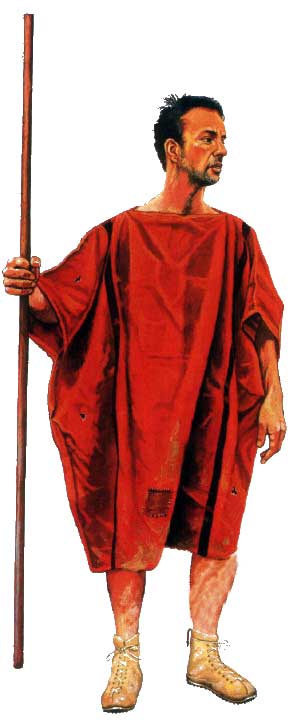 As the tunica and belt were important for recognizing a soldier, one form of punishment for a miles was public
humiliation by him making him stand around the front gate of the castra with his tunica unbelted, as shown here.
As the tunica and belt were important for recognizing a soldier, one form of punishment for a miles was public
humiliation by him making him stand around the front gate of the castra with his tunica unbelted, as shown here.

